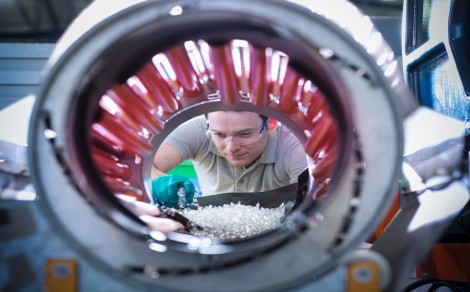- Home » Editorial » Hydraulics
Innovation starts with lubrication: Maintenance practices to improve the efficiency of your hydraulic equipment today and tomorrow

There is a growing demand for plastic injection moulded parts. The machinery’s ability to manufacture identical parts to a high-quality finish in a cost-effective way, has led to plastics injection moulded parts becoming a popular alternative to metal across a variety of sectors from medical to automotive. This places pressure on operators to ensure that their machinery is operating at peak efficiency, to stay competitive in a growing market. We spoke to Jake Sutton, Shell Lubricants UK Technical Manager at Shell Lubricants to gain some insights about the potential impact of hydraulic fluid choice and maintenance regimes on equipment productivity, lifespan, and efficiency and how it can help improve your total cost of ownership.
Q: What are some of the costs companies can pay through adhering to a poor maintenance regime for their plant and equipment?
A: One of the most common misconceptions among equipment users is that their maintenance regime should only start once their equipment stops. However, growing demand for high quality manufactured products in an output intensive industry, and the strain that this places on plastics injection moulding equipment, means that the repercussions of a poor maintenance regime are stronger than ever before. Poor maintenance can reduce a factory’s productivity by 5-20%, which ultimately impacts total cost of ownership. [1] Preventable maintenance issues such as varnish and sludge can develop as a result of improper hydraulic fluid condition.
Varnish and sludge are by-products of oxidation and thermal degradation of oils. The decomposed hydrocarbons, if left untreated, can lead to costly equipment failures such as blocked filters and sticking valves. Similarly, if your lubrication becomes contaminated with water, rust particles will begin to form, or if undissolved air enters your hydraulics system machine compressibility increases and can damage pumps and impede operational efficiency. This can all lead to unplanned downtime and reduce the lifespan of your machinery.
Arguably, the most significant cost of poor maintenance is unplanned downtime. For plastics injection moulding equipment, running with optimum precision and efficiency whilst operating at peak productivity is pivotal to maximising output. However, if equipment fails unexpectedly, operators will not only accrue costs from fixing or replacing their machinery, but from lost production during equipment downtime.
Adopting a pro-active maintenance regime allows operators to reduce maintenance and equipment costs, and unplanned downtime, in turn helping lower total cost of ownership and improving competitiveness.
Q: How can companies improve the performance and total cost of ownership of their plant and equipment through choosing the right type of lubricants?
A: Another common misconception within the industry is that an effective maintenance regime comes at a great cost. However, research has found that up to 70% of equipment failures in injection moulding machines are a result of improper hydraulic fluid condition.[2]. On average, hydraulic fluid represents less than 2% of overall operating costs of a plastic injection moulding plant, so simply taking the time to think about the quality, performance and condition of your equipment’s lubrication could generate some big savings.1
-
PPMA 2025
23 September, 2025, 9:30 - 25 September, 2025, 16:00
NEC, Birmingham UK -
Advanced Engineering Show 2025
29 October, 2025, 9:00 - 30 October, 2025, 16:00
NEC, Birmingham UK










